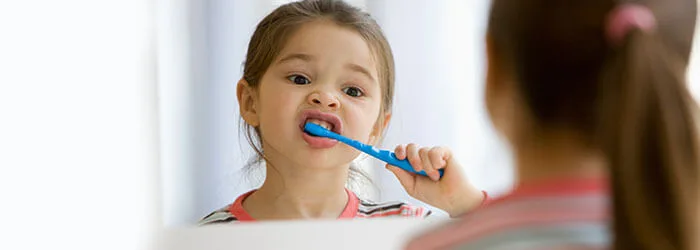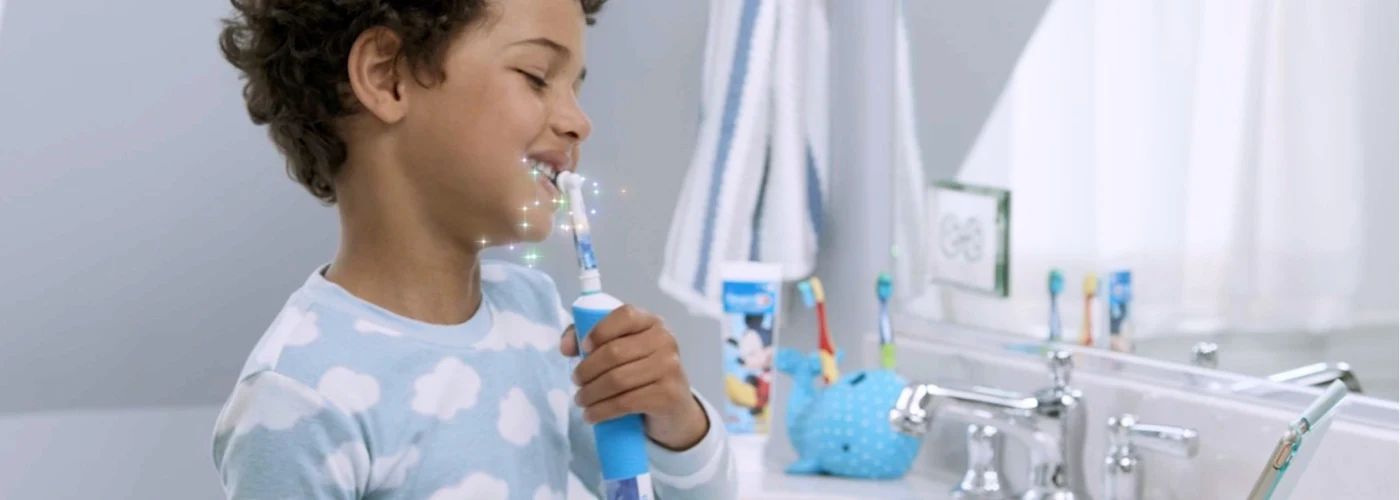
Everyone loves to see a child's smile. From the moment they get their first tooth, it’s time for you to begin a daily brushing habit. Once teeth emerge (or “erupt), they are susceptible to tooth decay. Primary teeth keep your child’s jaw straight, hold the space for adult teeth, and play an important role in how children learn to chew, smile, and talk. Having healthy teeth will also help with confidence and participation in their education and social life. Establishing good daily brushing habits early on will help encourage a lifelong pattern of good oral health.
It’s never too early to get children in the habit of good oral care. Of course, it’s up to parents to take the “first steps.” Finding new ways to model good dental habits and practice them with your kids is key. The sooner kids begin to take charge of their own teeth, the happier and healthier they (and you) will be. And the payoffs over a lifetime are immeasurable.
If you think it’s a challenge to teach your kids good oral care, you’re in good company. Tooth decay is one of the most common childhood diseases. And studies show that almost 50% of kids between six and eight have had at least one cavity.* These are just a couple of reasons why it’s so important to help kids understand right from the start that proper dental habits are a smart idea.
How to Care for Babies’ Teeth for Ages 0-2
There’s a lot of information you can discover, but these basics are a good beginning.
Help prevent plaque bacteria by gently cleaning a new-born baby’s gums with a damp cloth after feedings. Just be sure to use water only, not toothpaste.
When brushing, make circular motions just like you do with your own teeth. Make sure your baby isn't swallowing toothpaste. It's unlikely your baby will be able to spit out the toothpaste. So afterwards, simply wipe away the excess. This allows fluoride to remain in the mouth and protect the teeth.
Once teething begins at about 4 to 6 months, switch to a toothbrush with extra-soft bristles such as the Oral-B Baby 0-2 Winnie the Pooh toothbrush. Use a smear of fluoride toothpaste with at least 1100 ppm of fluoride, such as the Oral-B Baby Winnie the Pooh toothpaste.
Don’t put your baby to bed with a bottle of formula or juices that contain sugar. In fact, try to avoid sugary drinks and foods altogether. Try and encourage your child to get used to a free flow cup from 6 months onwards, and by age 1, try to stop them using a bottle completely.
Even babies can develop gingivitis, decay, and cavities, so it’s a good idea to see a pediatric dentist early—use a “first visit by first birthday” strategy.
How to Care for Toddlers’ Teeth for Ages 3-5
Now that your child’s teeth have come in, keeping them clean is key to healthy adult teeth. Brushing can be challenging at this age, but it’s still important to keep their teeth clean twice a day. Here are some helpful tips to make brushing easier.
Showing by example and making it fun is the name of the game. When everyone brushes at the same time, it becomes a family ritual that kids look forward to.
At about age two, it’s okay to start using fluoride toothpaste—but make sure there’s no swallowing. Want to teach the proper length of time for brushing? Try singing “Twinkle Twinkle Little Star” or another upbeat favourite for two minutes.
Use a pea-sized amount of fluoride toothpaste with no less than 1100 ppm fluoride, which helps protect and strengthen the enamel on the teeth. Try to use mild, mint-flavored toothpaste so your child gets used to it. It will be easier to switch to an adult toothpaste when the time comes.
Oral-B® Electric Toothbrushes for kids have lots of designs that feature popular Disney, Disney•Pixar and Star Wars characters. Starting at age 3, it's safe to brush a child's teeth with an electric toothbrush as long as a parent brushes their teeth.
Usually by ages three or four, all 20 primary or “baby” teeth have appeared. Permanent, or “adult,” teeth appear by age six and may continue to emerge into the teen years.
If you have a toddler who is afraid of the dentist, you might make your little one more comfortable by letting him or her sit in your lap during the exam.
How to Care for Teeth for Ages 6 to 12
You should still be in charge of brushing your child's teeth through age 7. Letting them attempt to improve their technique is fine. However, you will still need to brush them yourself. As they get closer to age 8, you can start letting them brush their own teeth, but you should still be supervising.
As kids get older, they want to feel more independent. Part of growing up includes assuming responsibility for taking care of their own teeth—without prompting from parents. Appeal to what matters to them: Kids want to look good to their peers, they want to smile in selfies, and they don’t want to spend their free time sitting in the dental professional's chair.
Brushing should be the last thing they do before bedtime and should occur on one other occasion during the day.
Brush their teeth for two minutes with a child-sized, soft- or medium-bristled toothbrush. Oral-B has a wide selection of manual and electric toothbrushes available, including the Oral-B Junior Smart Electric Toothbrush, which has a red light that flashes if they're brushing too hard.
After brushing, your child should spit out the toothpaste but not rinse with water. This keeps a strengthening layer of fluoride on their teeth.
If using a power toothbrush, your child just needs to hold the toothbrush in place and let it do all the work. Do this for a few seconds on each tooth using the same brushing action on all outer and inner tooth surfaces and tilting the brush as needed to better reach the insides of smaller front teeth.
If using a manual toothbrush, your child should place the brush at a 45-degree angle from the gum line, then apply gentle pressure while moving in a circular motion.
At about age 8, your child can be allowed to brush their own teeth. Some supervision will still be necessary. For the most part, children should be able to do this independently.
To teach kids more about proper brushing time, try the Disney Magic Timer App.
Another big challenge for children is avoiding sugary snacks and drinks. Healthier snack options let them enjoy better dental and overall health. If your kids are involved in sports, a mouth guard to protect their teeth from injury can keep them safe and looking good for a lifetime.
Flossing is an important lesson to teach. You might also want to ask your dental professional about sealants or fluoride treatments for added protection against decay.
* NIH.gov: Oral Health in America: A Report of the Surgeon General
Take the fright out of holiday candy with these oral care tips.
It’s hard to find a child that doesn’t love holidays—especially ones that are accompanied with heaps of candy and treats, like Halloween, Valentine’s Day and Easter.
But with tooth decay the most common chronic childhood disease, it is important to teach your child early about the damage that too much candy can inflict on their teeth and gums and what you can both do to help prevent it.
Every time we eat, bacteria interact with our food to produce acids that attack teeth, leading to decay. The more sugar, the more acid that gets produced, which is why sugary, sticky foods and beverages are more likely to create decay. This is especially true between meals, when the mouth produces less saliva to combat and neutralize the acids, allowing them to do more damage.
Here are some simple ways to combat the effects of sugar on your kid’s oral care:
Save treats like candy, cookies and pies for after mealtime since this is when the amount of saliva produced in the mouth is greater and will therefore better help protect your child’s teeth.
Dairy acts as a buffer to the acids produced by oral bacteria, decreasing the possibility of tooth decay. So consider serving your children milk or cheese with holiday candies and treats.
Hard candy can get stuck between kids’ teeth, which can cause cavities. Flossing can help remove the candy particles.
To help pace the amount of candy your child is consuming around holidays like Halloween and Easter, store excess candy in a sealed container and establish set times when your child can have a treat.
Encourage children to drink more water to help prevent tooth decay. If you choose bottled water, check the label for fluoride content. Fluoridated water can reduce the number of cavities children get in their baby teeth.
Related Articles
Sign Up
for expert advice and exclusive offers






